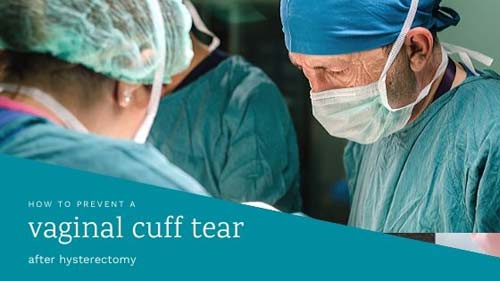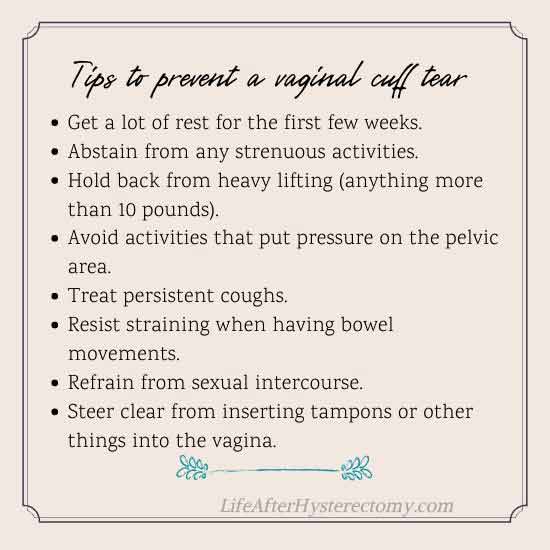How to prevent a vaginal cuff tear after hysterectomy
A vaginal cuff tear, also referred to as vaginal cuff dehiscence, is when the wound partly or completely opens up. Although it is a highly unusual complication, it can become a medical emergency. For this reason, women should know about the precautions they can take to prevent this from happening.
This blog is reader-supported. When you buy through a link on our site, we earn a commission at no extra cost to you. Read more

Depending on the type of hysterectomy you have, it may be necessary for your surgeon to create a vaginal cuff. This is performed in the area where your vagina and cervix normally meet and involve sewing the top part of your vagina together.
A vaginal cuff will only be created if your cervix is removed as part of your hysterectomy. However, if you have a partial hysterectomy and your cervix is still present, there isn’t any need for a vaginal cuff.
We will try to give you a better insight into what you can expect to recover from vaginal cuff surgery and what to look out for as you heal.
Does a Vaginal Cuff Affect the Vagina?
Some women are worried that a vaginal cuff will affect the size of their vagina, but generally, it doesn’t have much impact. Contrary to what many women fear, a vaginal cuff doesn’t physically make the vagina smaller.
Some women report that their vagina feels smaller after a vaginal cuff has been created, but this could be due to a temporary stiffness in the vaginal muscles, which often relax later. This is usually once you can become sexually active again.
Some experts suggest that the vagina can take as long as a year to fully heal and regain its elasticity, which is probably why it can feel different for some time afterward (even when you assume that you are completely recovered).
Recovery
Medications may be given while you’re still in the hospital to reduce infection risk and help with pain relief.
The general recovery time from a hysterectomy with a vaginal cuff is around 6 to 8 weeks. However, it may take longer for some women, and it is sometimes the case that complications can continue to happen beyond this point.
It’s best to avoid any activities that will potentially damage the cuff. Doing too much, too soon, can cause complications. It can potentially lead to vaginal bleeding when the wound sutures start to open up slightly.
Mild vaginal bleeding can sometimes happen from the vaginal cuff suture site. This can be a big worry if you assume that having no uterus means that you won’t bleed again, but the bleeding is related to the vaginal cuff incision.
If the bleeding is heavy, it may be a sign that the wound has opened up again. It’s best to seek medical advice if this happens to you.
Granulation tissue at the vaginal cuff
Some women experience yellow vaginal discharge as a result of granulation tissue on the vagina cuff. This isn’t that uncommon, given that the vagina is a moist environment. It can take longer for incisions to heal properly than incisions on the outside body.
Granulation tissue is essentially scar tissue that starts to form over the vaginal cuff, slowing down recovery. If a check-up reveals that you have granulation tissue on your vaginal cuff, it is often possible for your gynecologist to remove it in their office using silver nitrate or cauterization. This can be painful, and you may experience stomach cramping and a dark vaginal discharge, and vaginal “spotting” for a couple of days afterward.
Vaginal Cuff Tear
Fortunately a rare occurrence, but it is possible that a tear develops in the incision of the vaginal cuff area after hysterectomy surgery.
This is slightly more common after a laparoscopic hysterectomy than vaginal or abdominal hysterectomies (possibly due to the way the wound is closed). Still, it’s not a common problem, regardless of your surgery type.
The main risk factors that can make you more likely to suffer a tear include:
- Putting a lot of pressure on the abdomen and pelvis before you have fully recovered – this includes coughing and constipation, as well as being too active early on in your recovery
- Weak pelvic floor muscles
- Vaginal atrophy
- Vaginal hematoma
- Having previously had radiation in your pelvic area
- Developing a pelvic infection or abscess
- Receiving immunosuppressant therapy
- Lifestyle factors such as being overweight and smoking
A vaginal cuff tear is something to be aware of, though, given that it is a potentially life-threatening complication.
If that is the case, you’ll need surgery to repair it. If it is only a partial tear and you don’t have any complications linked to it, this can often be done vaginally. It is generally quite a lengthy recovery time after vaginal cuff repair surgery and could take up to 3 months.
What you can do to prevent dehiscence (opening up) of the vaginal cuff.
During the first 6-8 weeks, you’ll be advised to avoid anything that could stop the repair incision from healing properly. This includes

This part of recovery is vital as there have been cases in which women had experienced a vaginal cuff tear due to doing these activities before it was advisable.
Vaginal cuff tear symptoms
How can you tell if you may have developed a vaginal cuff tear? Symptoms of torn internal stitches after hysterectomy are:
- Fever
- Pain in your abdomen
- Pelvis and lower back pain
- Vaginal bleeding
- A watery or smelly vaginal discharge
- Fluid suddenly leaks out of the vagina.
- The feeling of pressure in the vagina.
Complete vaginal cuff dehiscence
As one of the more serious symptoms of a tear, the bowels can start protruding through the wound separation into the vagina (known as bowel evisceration). This is when the situation can become life-threatening. The occurrence of vaginal cuff dehiscence is estimated to be about 0.03%. This may be higher or lower, depending on the type of surgery performed.
If you’re concerned that vaginal cuff dehiscence has developed, seek medical advice as soon as possible, as the condition can sometimes prove fatal.
All things considered
You can avoid serious cuff complications after surgery by strictly following the instructions given by your doctor or the hospital. Don’t forget the vaginal cuff after hysterectomy will take more time to heal than the external wound.
Typically, you will be given a postoperative follow-up appointment after 6 weeks. This includes an internal exam to check if your cuff is healing well so you can return to your regular activities.
Related posts
- How to prevent a vaginal cuff tear after hysterectomy
- Tips to Prevent Blood Clots after Hysterectomy That Can Save your Life
- Stressed About Hysterectomy Risks? What Every Woman Must Know
- Pain After Hysterectomy- Tips To Identify Its Source
- 5 Main causes of bowel problems after hysterectomy


I had my second vaginal cuff repair January 25, 2022. Yes, it is a rare complication, and even rarer that it would happen again. I did everything per doctors orders. Recover well from laparoscopic robotic hysterectomy September 7, cleared 6 weeks for everything. First repair was November 12, cleared for all activities January 3. Tore the cuff 10 weeks after the first cuff repair surgery. Of course, I’m worried. And wondering how long this recovery is going to be.
I also wasn’t told anything about this. I’m 5 weeks out now and have had some lower pelvic discomfort…
I wasn’t informed of this possibility before agreeing to a recent hysterectomy. I’m 4 weeks post op and have had several times where I’ve had to strain to have a bowel movement. Even with colace, mag citrate, plenty of water, fruits and veges. I try not to, but it’s happened. I no longer take any pain med due to the constipation, but still dealing with it.